Officials at the Pompeii archaeological site have announced a dramatic new discovery, the skeleton of a man crushed by an enormous stone while trying to flee the explosion of Mt. Vesuvius in 79 A.D.
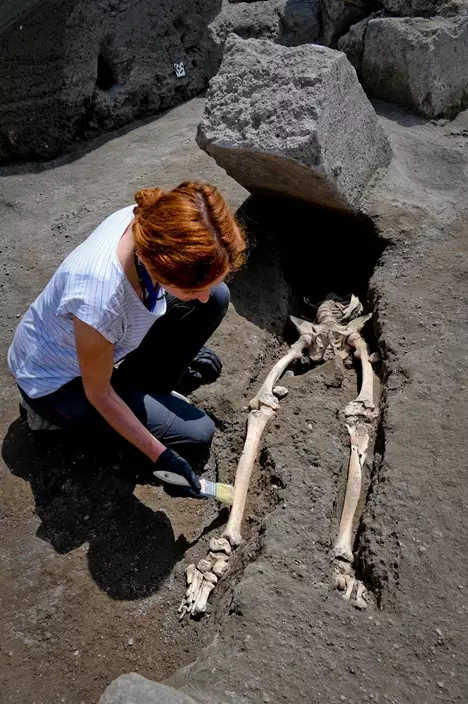
Anthropologist Valeria Amoretti works with a brush on a skeleton of a victim of the eruption of Mt. Vesuvius in A.D. 79, which destroyed the ancient town of Pompeii, at Pompeii' archeological site, near Naples, on Tuesday, May 29, 2018. The skeleton was found during recent excavations and is believed to be of a 35-year-old man with a limp who was hit by a pyroclastic cloud during the eruption. (Ciro Fusco/ANSA via AP)
Pompeii officials on Tuesday released a photograph showing the skeleton protruding from beneath a large block of stone that may have been a door jamb that had been "violently thrown by the volcanic cloud."
Click to Gallery
Officials at the Pompeii archaeological site have announced a dramatic new discovery, the skeleton of a man crushed by an enormous stone while trying to flee the explosion of Mt. Vesuvius in 79 A.D.
Pompeii officials on Tuesday released a photograph showing the skeleton protruding from beneath a large block of stone that may have been a door jamb that had been "violently thrown by the volcanic cloud."
The victim, who was over 30, had his thorax crushed. Archaeologists have not found the victim's head. Officials said the man suffered an infection of the tibia, which may have caused walking difficulties, impeding his escape.
The archaeological site's general director, Massimo Osanna, called it "an exceptional find," that contributes to a better "picture of the history and civilization of the age."
Anthropologist Valeria Amoretti works with a brush on a skeleton of a victim of the eruption of Mt. Vesuvius in A.D. 79, which destroyed the ancient town of Pompeii, at Pompeii' archeological site, near Naples, on Tuesday, May 29, 2018. The skeleton was found during recent excavations and is believed to be of a 35-year-old man with a limp who was hit by a pyroclastic cloud during the eruption. (Ciro Fusco/ANSA via AP)
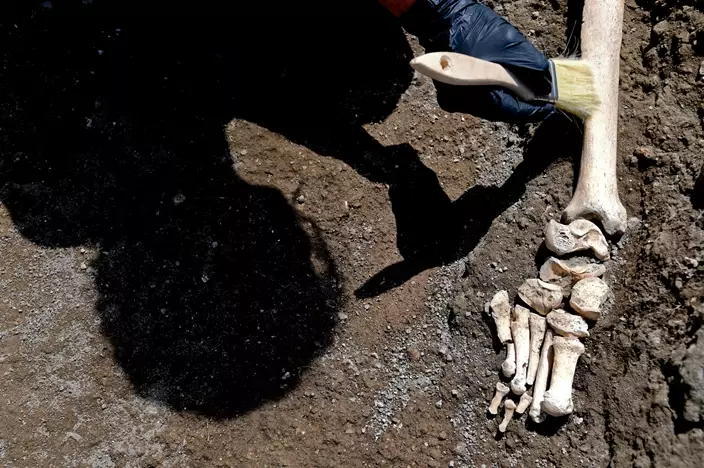
Anthropologist Valeria Amoretti works with a brush on a skeleton of a victim of the eruption of Mt. Vesuvius in A.D. 79, which destroyed the ancient town of Pompeii, at Pompeii' archeological site, near Naples, on Tuesday, May 29, 2018. The skeleton was found during recent excavations and is believed to be of a 35-year-old man with a limp who was hit by a pyroclastic cloud during the eruption. (Ciro Fusco/ANSA via AP)
The victim, who was over 30, had his thorax crushed. Archaeologists have not found the victim's head. Officials said the man suffered an infection of the tibia, which may have caused walking difficulties, impeding his escape.
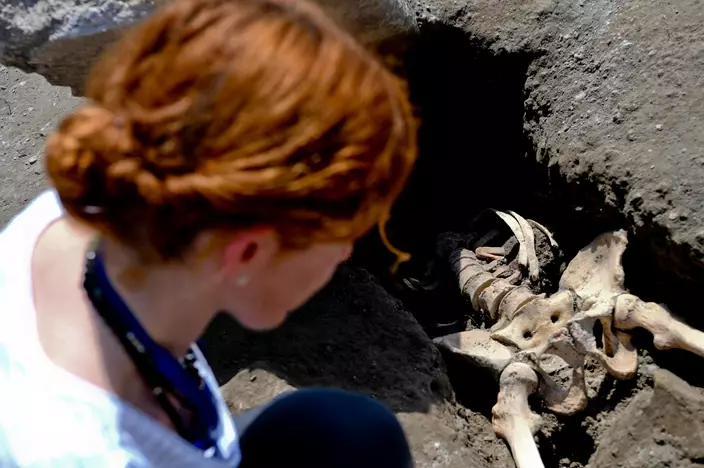
Anthropologist Valeria Amoretti looks at a skeleton of a victim of the eruption of Mt. Vesuvius in A.D. 79, which destroyed the ancient town of Pompeii, at Pompeii' archeological site, near Naples, on Tuesday, May 29, 2018. The skeleton was found during recent excavations and is believed to be of a 35-year-old man with a limp who was hit by a pyroclastic cloud during the eruption. (Ciro Fusco/ANSA via AP)
The archaeological site's general director, Massimo Osanna, called it "an exceptional find," that contributes to a better "picture of the history and civilization of the age."

The legs of a skeleton emerge from the ground beneath a large rock believed to have crushed the victim's bust during the eruption of Mt. Vesuvius in A.D. 79, which destroyed the ancient town of Pompeii, at Pompeii's archeological site, near Naples, on Tuesday, May 29, 2018. The skeleton was found during recent excavations and is believed to be of a 35-year-old man with a limp who was hit by a pyroclastic cloud during the eruption. (Ciro Fusco/ANSA via AP)
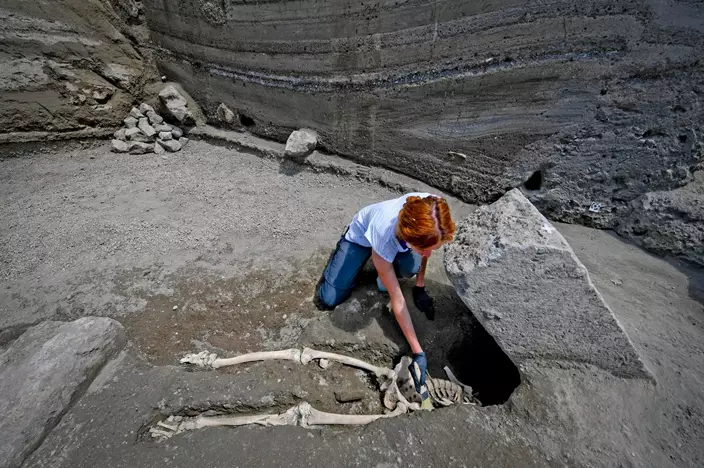
Anthropologist Valeria Amoretti works with a brush on a skeleton of a victim of the eruption of Mt. Vesuvius in A.D. 79, which destroyed the ancient town of Pompeii, at Pompeii' archeological site, near Naples, on Tuesday, May 29, 2018. The skeleton was found during recent excavations and is believed to be of a 35-year-old man with a limp who was hit by a pyroclastic cloud during the eruption. (Ciro Fusco/ANSA via AP)
MANADO, Indonesia (AP) — Indonesian authorities closed an airport and residents left homes near an erupting volcano Thursday due to the dangers of spreading ash, falling rocks, hot volcanic clouds and the possibility of a tsunami.
Mount Ruang on the northern side of Sulawesi Island had at least five large eruptions Wednesday, causing the Center for Volcanology and Geological Disaster Mitigation to issue its highest-level alert, indicating an active eruption.
The crater emitted white-gray smoke continuously during the day Thursday, reaching more than 500 meters (1,600 feet) above the peak.
People have been ordered to stay at least 6 kilometers (3.7 miles) from the 725-meter (2,378 foot) mountain. More than 11,000 people live in the affected area and were told to leave. At least 800 have done so.
An international airport in Manado city was temporarily closed Thursday as volcanic ash was spewed into the air.
“We have to close flight operations at Sam Ratulangi Airport due to the spread of volcanic ash, which could endanger flight safety,” said Ambar Suryoko, head of the regional airport authority.
Eruptions Wednesday evening spewed volcanic ash approximately 70,000 feet into the atmosphere, according to the Australian Bureau of Meteorology’s Volcanic Ash Advisory Centre. The bureau said in a statement Thursday it was tracking and forecasting the ash dispersion.
Indonesia's volcanology center noted the risks from the volcanic eruption include the possibility that part of the volcano could collapse into the sea and cause a tsunami. In December 2018, Indonesia’s Anak Krakatau volcano island erupted and collapsed, losing around 3/4 its volume and triggering a powerful tsunami that killed more than 400 people. An 1871 eruption at Mount Ruang also triggered a tsunami.
Tagulandang Island, east of the Ruang volcano, could be at risk if a collapse occurred. Its residents were among those being told to evacuate.
“People who live in the Tagulandang Island area and are within a 6-kilometer radius must be immediately evacuated to a safe place outside the 6-kilometer radius," Abdul Muhari, spokesperson of the National Disaster Mitigation Agency, said Thursday. “And especially those who live near the coast should be aware of the potential for incandescent rocks to erupt, hot clouds and tsunami waves that could be triggered by the collapse of a volcanic body into the sea.”
The agency said residents will be relocated to Manado, the nearest city, on Sulawesi island — a six-hour journey by boat.
Indonesia, an archipelago of 270 million people, has 120 active volcanoes. It is prone to volcanic activity because it sits along the “Ring of Fire,” a horseshoe-shaped series of seismic fault lines around the Pacific Ocean.
AP writer Rod McGuirk contributed from Sydney.
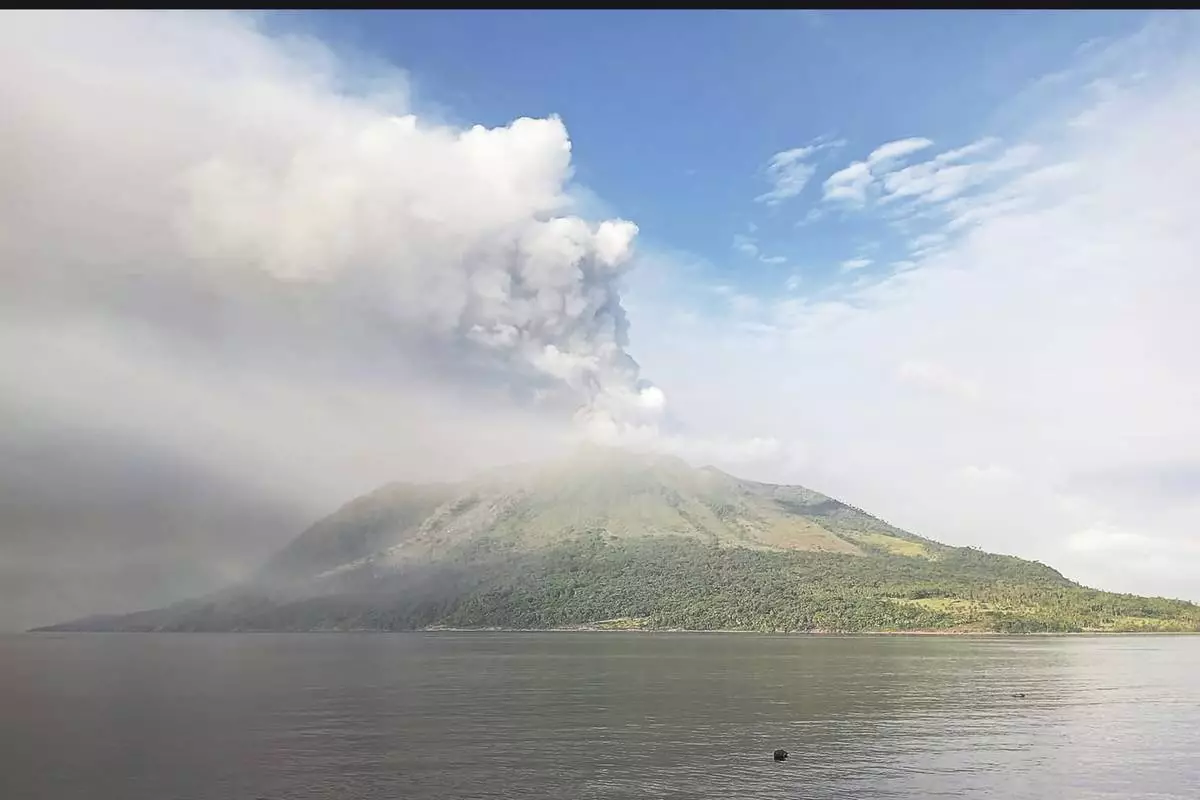
Mount Ruang volcano is seen during the eruption from Tagulandang island, Indonesia, Thursday, April 18, 2024. Indonesian authorities closed an airport and residents left homes near an erupting volcano Thursday due to the dangers of spreading ash, falling rocks, hot volcanic clouds and the possibility of a tsunami. (AP Photo/ Hendra Ambalao)
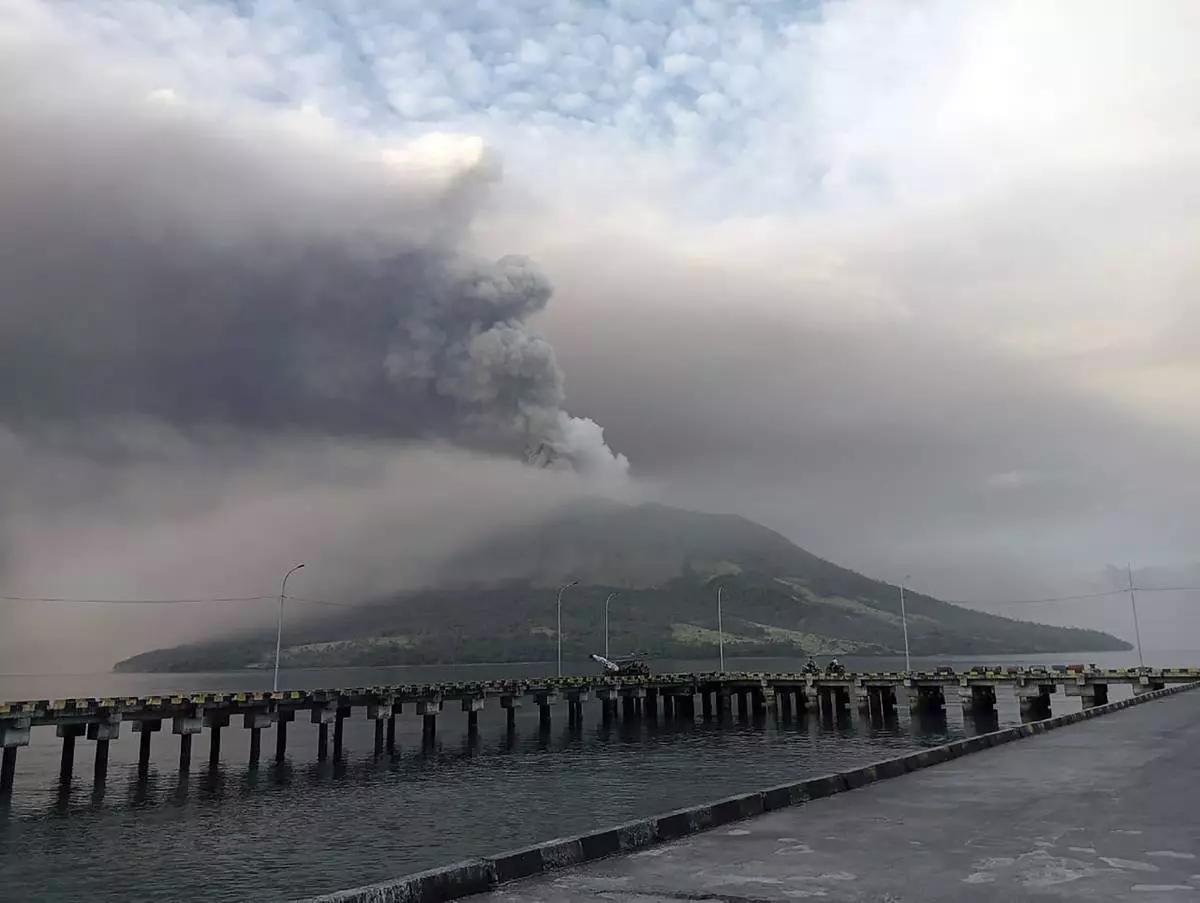
Mount Ruang volcano is seen during the eruption from Tagulandang island, Indonesia, Thursday, April 18, 2024. Indonesian authorities closed an airport and residents left homes near an erupting volcano Thursday due to the dangers of spreading ash, falling rocks, hot volcanic clouds and the possibility of a tsunami. (AP Photo/ Hendra Ambalao)

In this photo provided by the Indonesian Transportation Ministry, people inquire about their flight change at the closed Sam Ratulangi Airport in Manado, North Sulawesi, Indonesia, Friday, April 19, 2024. Indonesian authorities closed the airport and residents left homes near an erupting volcano Thursday due to the dangers of spreading ash, falling rocks, hot volcanic clouds and the possibility of a tsunami. (Indonesian Transportation Ministry via AP)

This photo provided by the Indonesian Transportation Ministry shows the closed Sam Ratulangi Airport in Manado, North Sulawesi, Indonesia, Friday, April 19, 2024. Indonesian authorities closed the airport and residents left homes near an erupting volcano Thursday due to the dangers of spreading ash, falling rocks, hot volcanic clouds and the possibility of a tsunami. (Indonesian Transportation Ministry via AP)
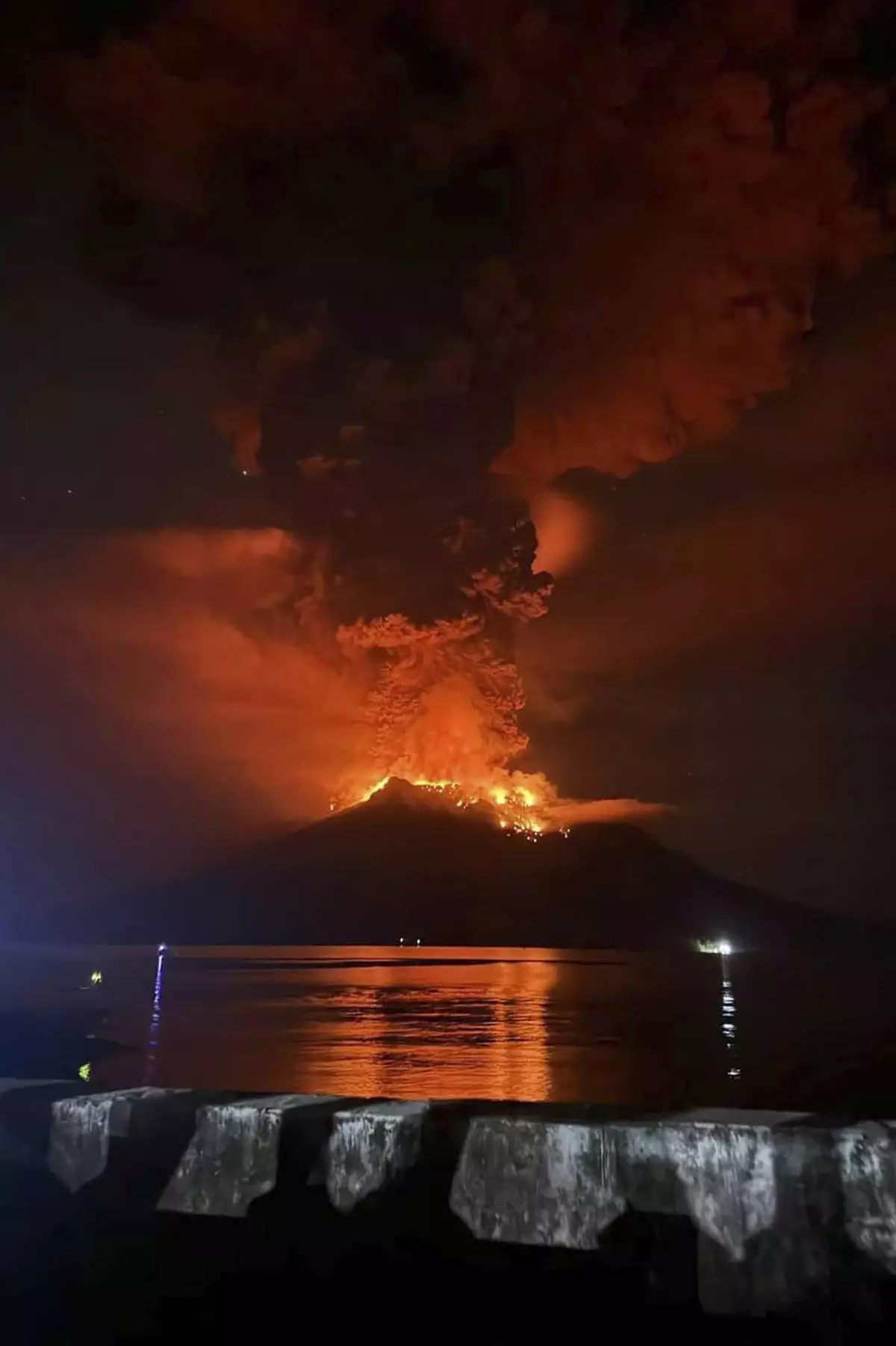
In this photo released by Sitaro Regional Disaster Management Agency (BPBD Sitaro), hot molten lava glows at the crater of Mount Ruang as it erupts in Sanguine Islands, Indonesia, Wednesday, April 17, 2024. Indonesian authorities issued a tsunami alert Wednesday after eruptions at Ruang mountain sent ash thousands of feet high. Officials ordered more than 11,000 people to leave the area. (BPBD Sitaro via AP)














